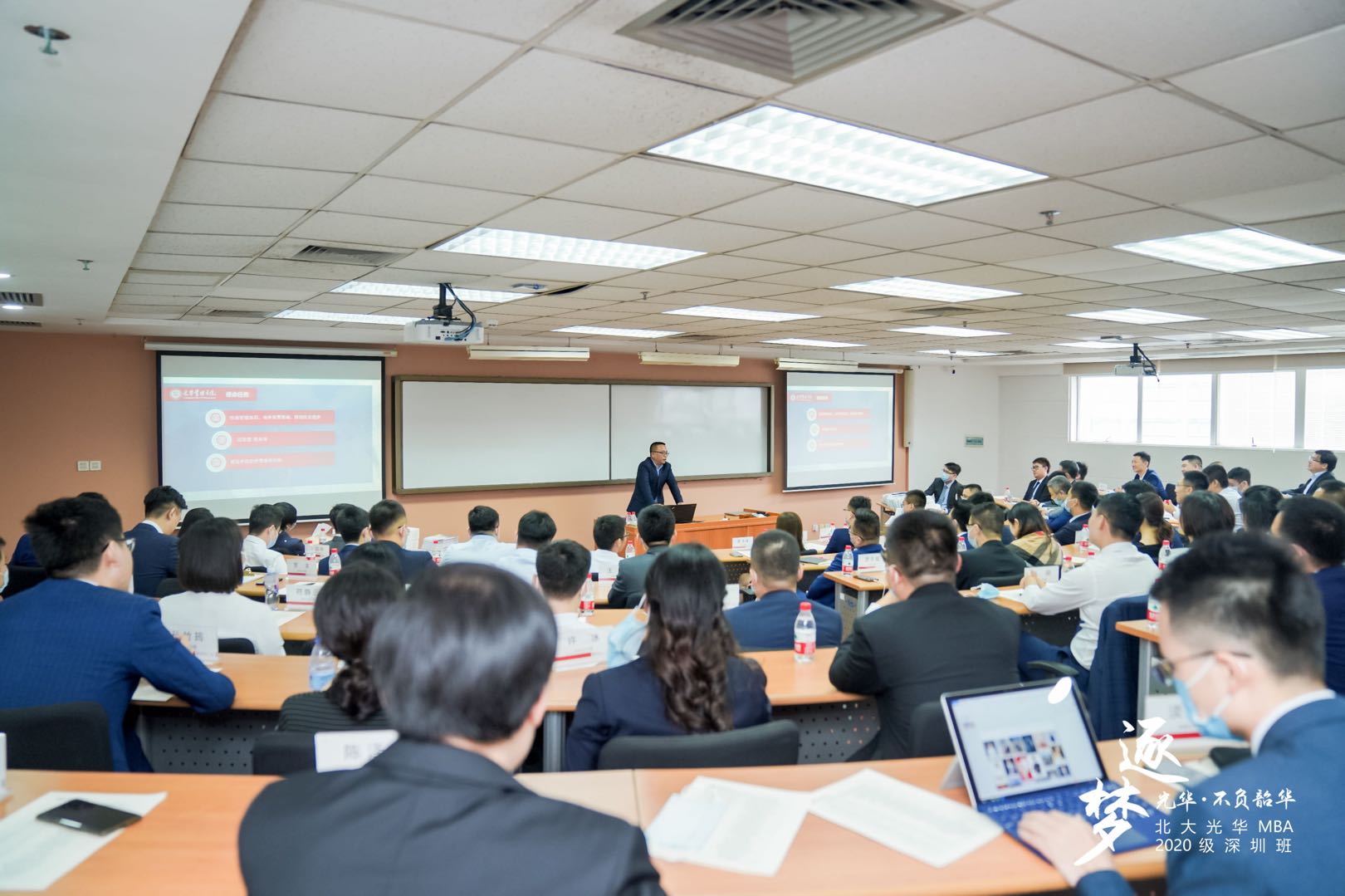Forty years ago,a city in south China was known as the Bao’an County, and its locals dreamed of fleeing to the neighboring heaven called Hong Kong.
Thirty-five years ago, a business school was founded in Beijing, with the aim to pool wisdom for China’s development.
Thirty years ago, this city welcomed millions of talents from across China as the country embraced bolder reform and opening-up.
Twenty-one years ago, this business school arrived in the city, and the two kickstarted a strong bond in the form of the Shenzhen campus of Peking University’s Guanghua School of Management.
They have been growing together and supporting each other ever since.
Over the past 21 years, Guanghua’s Shenzhen campus has become a crucial platform for learning cutting-edge business knowledge and studying management cases, training thousands of high-quality management talents for south China’s regional economic development. The campus has been driving the city’s progress as it achieved one miracle after another in the global history of modernization, industrialization and urbanization.
In 2020, the duo was once again in the spotlight. On Oct. 14, President Xi Jinping delivered a keynote speech at a grand gathering celebrating the 40th anniversary of the establishment of the Shenzhen Special Economic Zone(SEZ). Previously, the country’s leadership issued a plan on implementing pilot reforms in Shenzhen to build the city into a demonstration area of socialism with Chinese characteristics in the next five years.
Will there be more miracles in this southern city? What could Guanghua do to support it?

DESTINED ENCOUNTER
Located in the city’s Nanshan Science and Technology Park,Guanghua’s Shenzhen campus is still at a tender age compared to Peking University’s history of more than 120 years. Yet, these 21 years marked the campus’s rapid growth from birth to prosperity.
According to Liu Qiao, dean of Guanghua,the Shenzhen one is the school’s first campus outside Beijing, followed by others in Shanghai, Xi’an and Chengdu,and each of these campuses is closely related to China’s national development strategies. Founded in 1999, the Shenzhen campus aims to back the development of the Pearl River Delta and the Guangdong-Hong Kong-Macao Greater Bay Area, regions at the forefront of the country’s reform and opening-up drive.
Coming to Shenzhen is Guanghua’s destiny.
As Honorary Dean Li Yining said, Guanghua was shouldering the social responsibility of supporting China’s reform from day one. Itself the fruit of reform, Guanghua has been doing its fair share to push forward China’s reforms in multiple aspects such as building the legal system for its market economy and promoting the private economy.
In the late 1990s, Shenzhen was a fertile ground for the private economy and the market economy. With official approval,Guanghua set up an MBA program here in 1999.
“Many of those going to Shenzhen for business opportunities after 1992 started to see their efforts paying off at the turn of the millennium. Businesses were growing bigger while executives and business founders alike craved management knowledge,” said Zhang Zheng, Guanghua’s associate dean. “Our recruitment style was different then, and educational attainment was not a crucial factor. Many grassroots-level entrepreneurs and executives became our students, which was very much in line with the spirit of inclusion at the Peking University.” Since then, the campus’s personnel cultivation system has been evolving in accordance with Shenzhen’s demand.
In March 2000, Guanghua’s first MBA program in the Shenzhen campus kicked off with a lecture by Professor Li Yining for the program’s 83 students.
In May 2002, Guanghua set up an EMBA office in the Shenzhen campus, and its first EMBA Shenzhen program began in Nov. with the participation of 56 students.
In Aug. 2003, Guanghua set up its Executive Education (ExEd) Shenzhen office. The campus has so far trained thousands of management talents through its MBA, EMBA and ExEd programs.
According to Zhang, the campus, sticking to the principle of “One School a Policy,” makes full use of Peking University’s profound experiences in humanities and an outstanding faculty team to create systemic, innovative courses to pass on cutting-edge business knowledge, cultivate daring, innovative business talents and push forward social progress.

IDEAS, TALENTS
The best kind of encounter between two persons is characterized by mutual support. It is the same with a school and a city.
The year 2020 marks the 40th anniversary of the establishment of the Shenzhen SEZ as well as the 21th anniversary of the founding of Guanghua’s Shenzhen campus. With the pilot reforms to build the city into a “demonstration area of socialism with Chinese characteristics” and support it to implement comprehensive authorized reform measures, Shenzhen is assigned another historic mission.
How can Guanghua’s Shenzhen campus grow in pace with the city?
Ideas and talents are the answer.
“Ideas are Guanghua’s most precious resource. In addition to cultivating talents, the Shenzhen campus will play a crucial role as a think-tank to contribute ideas and proposals for the development of Shenzhen and even the Greater Bay Area,” Zhang said, adding that Guanghua is already conducting research related to the new move.
Zhang cited a crucial research project proposed by China’s National Development and Reform Commission on key measures for the country’s market-based allocation of production factors such as labor forces, land, capital and technology as a reference for the drafting of the 14th five-year plan. Improving the market-based allocation of production factors is also mentioned in the new plan for Shenzhen.
Via the Guanghua Thought Leadership Platform, the school’s experts are conducting numerous research projects such as REITs, mechanism design and policy results analysis for the financial market’s micro-structure and liquidity, the impact of digitization on the financial industry, advices on stocks pledging, share repurchase and the science and technology innovation board as well as the capital market and innovation and business startups in the Greater Bay Area. These topics are all related to Shenzhen’s pilot reforms in the capital market.
Meanwhile, projects in the fields of improving the eco-system of science and technology innovation, the transmission and financing mechanism of major national projects, the crossover between artificial intelligence and social sciences as well as AI and patent concern efforts to transform science and technology achievements.
In the category involving the data factor market, Guanghua’s studies touch on factors affecting digital transformation, applied research based on micro-level big data, financial research based on bid data in payments, social credit research based on big data and the property rights system in the era of data.
In the field of innovative healthcare service, Guanghua’s research projects probe topics such as a patient-oriented healthcare model and empirical research on China’s healthcare system reform. A study on reforming the enterprise housing provident fund will help improve the country’s supply and service system for people’s livelihoods. Projects including innovation-driven regional integration and economic growth, solving private businesses’financing difficulties via deepened reforms, a report on China’s urban infrastructure construction and development as well as new infrastructure construction in the digital age focus on the country’s business environment.
According to Dean Liu Qiao, Guanghua’s research projects are all closely linked with China’s economic and commercial practices and are able to generate constructive advices and consultations on government policies and boost the country’s economic and social development. By discovering market patterns and trends, they can also help firms achieve better growth. Likening Shenzhen’s 40-year development to an academic gold mine that provide rich subjects for researchers, Liu is confident that these research projects will prove very useful ini helping the city realize new miracles.
In addition to cutting-edge ideas and empirical research, the Shenzhen campus also aims to cultivate talents in a more profound manner.
According to the new plan, efforts should be made to set up a globally competitive personnel management system to attract and make full use of high-caliber talents, including those from overseas. As an educational institution, Guanghua is constantly improving its talent-cultivating system.
Zhang Zheng said that Guanghua’s student recruitment and cultivation system will put more emphasis on employment and innovation opportunities as well as training more crossover talents bridging management and science and technology. “Further plans are being made concerning big data and artificial intelligence, and curriculum in the Shenzhen campus will be richer.”
Meanwhile, Guanghua is drafting and implementing a future development blueprint in Shenzhen that is more open, interactive, comfort, people-oriented and online education-friendly so that students are more willing to exchange ideas, discuss topics, read, think and research the space provided by Guanghua. This plan is also being vigorously supported by Guanghua alumni.
In one development, Guanghua’s “Future Leaders” International Undergraduate Program will be partially operated on the Shenzhen campus.
For Shenzhen, everything is unknown and yet hopeful — just like it was 40 years ago. And not unlike the moment it was founded, Guanghua’s Shenzhen campus knows exactly what it can do to galvanize this southern city. Both are ready to embrace the time of their lives.

